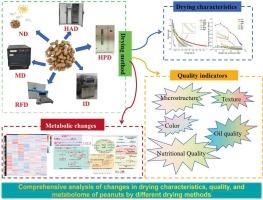Comprehensive analysis of changes in the drying characteristics, quality, and metabolome of peanuts by different drying methods
IF 8
1区 农林科学
Q1 FOOD SCIENCE & TECHNOLOGY
引用次数: 0
Abstract
To investigate suitable mechanical drying methods for peanuts, this study employed natural drying (ND), hot-air drying (HAD), heat pump drying (HPD), infrared drying (ID), radio frequency drying (RFD) and microwave drying (MD) and evaluated their effects on drying characteristics, hardness, microstructure, nutritional qualities (proteins, fats and amino acids), oil qualities (acid value, peroxide value and fatty acids) and metabolome level. The results indicated that MD had the highest drying efficiency but caused more damage to the microstructure, resulting in lower hardness and higher chewiness; HPD was superior in terms of colour and oil quality retention; and ID offered certain benefits in nutrient quality preservation. The two-term model was identified as the most suitable for predicting moisture changes during peanut drying. Non-targeted metabolomics analysis revealed that the different drying methods markedly altered the metabolite composition and pathways of peanuts. It also identified 1720 metabolites and 8 key metabolic pathways, among which the tricarboxylic acid cycle and glycine, serine and threonine metabolism were the principal metabolic pathways governing peanut drying. These findings establish a theoretical foundation for the enhancement of peanut-drying technologies and post-harvest processing and usage.

不同干燥方法对花生干燥特性、品质及代谢组变化的综合分析
为探索花生适宜的机械干燥方法,本研究采用自然干燥(ND)、热风干燥(HAD)、热泵干燥(HPD)、红外干燥(ID)、射频干燥(RFD)和微波干燥(MD),评价了不同干燥方法对花生干燥特性、硬度、微观结构、营养品质(蛋白质、脂肪和氨基酸)、油质(酸值、过氧化值和脂肪酸)和代谢组水平的影响。结果表明:MD的干燥效率最高,但对显微组织的破坏较大,硬度较低,嚼劲较大;HPD在颜色和油质保留方面优于HPD;和ID在营养品质保存方面具有一定的优势。结果表明,两项模型最适合预测花生干燥过程中的水分变化。非靶向代谢组学分析表明,不同干燥方法显著改变了花生的代谢物组成和代谢途径。鉴定出1720种代谢物和8条关键代谢途径,其中三羧酸循环和甘氨酸、丝氨酸和苏氨酸代谢是控制花生干燥的主要代谢途径。研究结果为改进花生干燥技术及采后加工利用奠定了理论基础。
本文章由计算机程序翻译,如有差异,请以英文原文为准。
求助全文
约1分钟内获得全文
求助全文
来源期刊

Food Research International
工程技术-食品科技
CiteScore
12.50
自引率
7.40%
发文量
1183
审稿时长
79 days
期刊介绍:
Food Research International serves as a rapid dissemination platform for significant and impactful research in food science, technology, engineering, and nutrition. The journal focuses on publishing novel, high-quality, and high-impact review papers, original research papers, and letters to the editors across various disciplines in the science and technology of food. Additionally, it follows a policy of publishing special issues on topical and emergent subjects in food research or related areas. Selected, peer-reviewed papers from scientific meetings, workshops, and conferences on the science, technology, and engineering of foods are also featured in special issues.
 求助内容:
求助内容: 应助结果提醒方式:
应助结果提醒方式:


